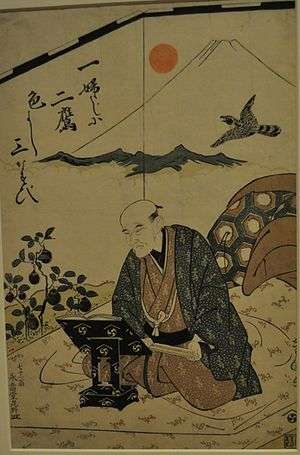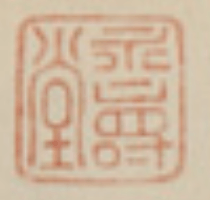Nishimura Yohachi
Nishimuraya Yohachi (dates unknown)[1] was one of the leading publishers of woodblock prints in late 18th Japan.[2] He founded the Nishimuraya Yohachi publishing house, also known as Nishiyo (西与),[3] which operated in Nihonbashi's Bakurochō Nichōme under the shop name Eijudō. The firm's exact dates are unclear, but many art historians date its activity to between c. 1751 and 1860.[4][5]

Portrait by Utagawa Toyokuni I commemorating 71st year of Nishimuraya Yohachi, c. 1799
According to Andreas Marks, Nishimuraya's "success came from engaging the best artists and providing a broad range of prints to satisfy the public's interest."[6] One of the press' most significant products was Hokusai's Thirty-six Views of Mount Fuji, which appeared between c. 1830 and 1833.[7] In addition to Hokusai, Nishimuraya Yohachi published prints by Eishi, Kuniyasu, Toyokuni I and Kunisada.[8] The store is immortalized in the 1787 print Scene of Print Buyers at the Shop of Nishimuraya Yohachi (Eijudou) on New Year’s Day by Torii Kiyonaga (1752–1815).[9]

Yohachi is known to have been a member of the Fuji-kō, an Edo period cult centred around Mount Fuji.[10] Founded by an ascetic named Hasegawa Kakugyō (1541–1646),[11] the cult venerated the mountain as a female deity, and encouraged its members to climb it.[12] In doing so, they would be reborn, "purified and... able to find happiness."[13] The cult waned in the Meiji period, and, though it persists to this day, it has been subsumed into Shintō sects.[14] The publisher's association with the Fuji-kō gives clues not only to imagery in his portrait by Utagawa Toyokuni I, but also to his eagerness to participate in the production of Hokusai's series celebrating Mount Fuji.
References
- "Mr. Edmonds, the cataloguer at Sotheby’s before the Second World War, seems to have been the first to suggest, in a catalogue of 1912, that Eijudō was born in 1729 and would therefore be seventy-one by Japanese reckoning, in 1799. 1799 is a plausible date for the print, but Edmunds cited no source for his information about the year of Eijudō's birth, and no recent Japanese scholar has proposed a date." (Museum Angewandte Kunst)
- Newland 2003, 475
- Newland 2003, 175
- Pushkin State Museum; Japanese Prints
- Newland is less precise, describing Nishimuraya as active from the "mid-eighteenth to mid-nineteenth century (2003, 475); Machotka chooses the period c. 1789–1830 (2009, 64), and Volker insists on 1738-1818 (1949, 20).
- Japanese Prints
- Newland 2003, 206
- Japanese Prints
- Part of the Gerhard Pulverer Collection currently housed at the Smithsonian's Freer Gallery.
- Honolulu Museum
- Melton 2008, 231
- Yamaguchi
- Yamaguchi
- Melton 2008, 231
Sources
- Machotka, Ewa. Visual Genesis of Japanese National Identity: Hokusai's Hyakunin Isshu. Brussels: Peter Lang, 2009.
- Marks, Andreas. Japanese Woodblock Prints: Artists, Publishers and Masterworks 1680-1900. Tokyo: Tuttle, 2010.
- Melton, J. Gordon. Encyclopedia of Religious Phenomena. Canton, MI: Visible Ink Press, 2008
- Newland, Amy Reigle. Ed. Hotei Encyclopedia of Woodblock Prints, vol. 2., 2003.
- Volker, T. Ukiyoe Quartet: publisher, designer, engraver and printer. Mededelingen van het Rijksmuseum voor Volkenkunde, Issue 5, Volume 129. Leiden: E. J. Brill, 1949.
- Japanese Prints. Nishimuraya Yohachi. Cowell-Thackray Collection of Japanese woodblock prints and works on paper. Accessed October 27, 2013.
- Honolulu Museum of Art. Portrait of Publisher Nishimuraya Yohachi I on His Seventy-first Birthday. Accessed October 28, 2013.